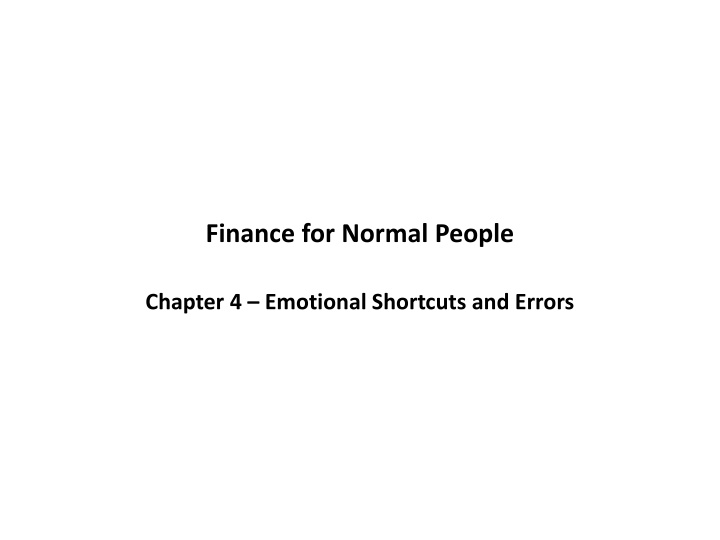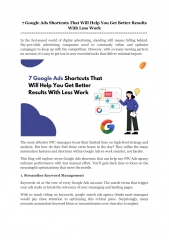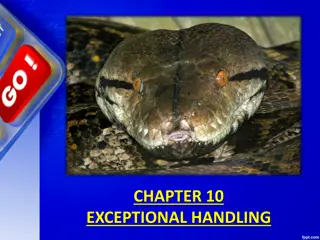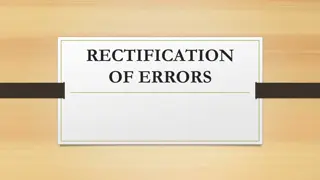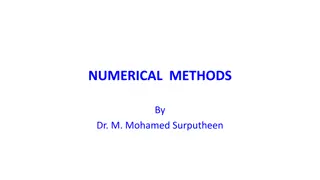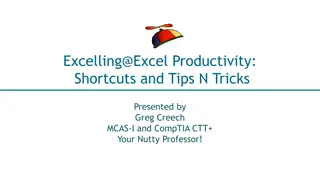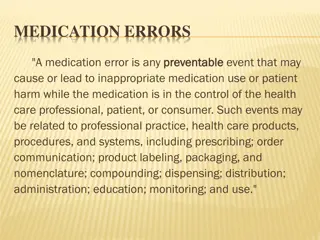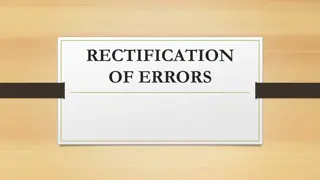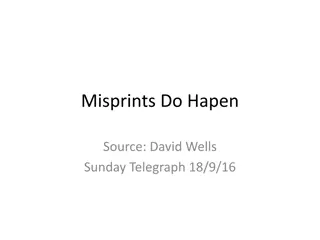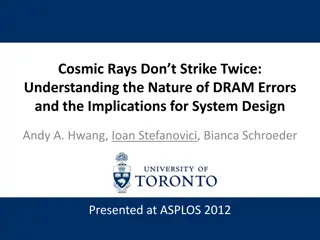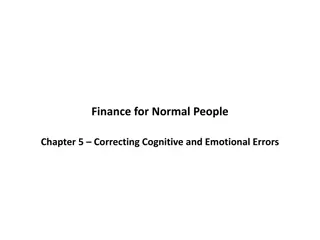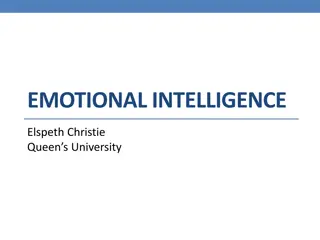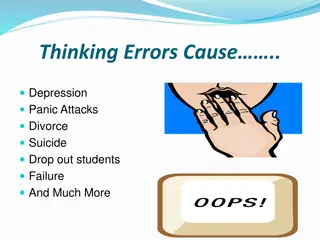Emotional Shortcuts and Errors in Financial Decision Making
Emotional shortcuts play a significant role in decision-making processes, often leading to errors when misinterpreted. Understanding the interplay between System 1 (intuitive) and System 2 (reflective) thinking modes is essential for making sound financial choices. Fear, cognition, and emotion interact to influence our decisions, sometimes resulting in outcomes contrary to logical reasoning. Recognizing the impact of emotions, mood, and affect on our financial behaviors is crucial to avoid common pitfalls in personal finance.
Download Presentation

Please find below an Image/Link to download the presentation.
The content on the website is provided AS IS for your information and personal use only. It may not be sold, licensed, or shared on other websites without obtaining consent from the author.If you encounter any issues during the download, it is possible that the publisher has removed the file from their server.
You are allowed to download the files provided on this website for personal or commercial use, subject to the condition that they are used lawfully. All files are the property of their respective owners.
The content on the website is provided AS IS for your information and personal use only. It may not be sold, licensed, or shared on other websites without obtaining consent from the author.
E N D
Presentation Transcript
Finance for Normal People Chapter 4 Emotional Shortcuts and Errors
Emotional Shortcuts and Errors Emotional shortcuts, like cognitive shortcuts, are part of the intuitive blink System 1 in our minds, leading to good choices in most of life But shortcuts turn into errors when they mislead us into poor choices System 2, the reflective think system in our minds leads to better choices when System 1 misleads
Emotional Shortcuts and Errors People with knowledge of human behavior and financial facts use emotional shortcuts correctly, whereas people lacking such knowledge commit emotional errors as they use them incorrectly
Emotional Shortcuts and Errors Fear Fear acts as an emotional shortcut that turns into an error when fear is absent or when it is exaggerated Fear guides us rightly when it prompts us to retreat from a knife-wielding stranger bearing an angry face, and when it prevents us from buying houses likely to be repossessed in foreclosures But fear guides us wrongly when it prompts us to retreat from a knife- wielding friend who chops vegetables, and when it compels us to sell all our stocks in a financial crisis
Emotional Shortcuts and Errors The interaction between cognition and emotion makes it difficult to attribute shortcuts, errors, and choices to one or the other Reason tells us that flying is safer than driving long distances, yet some choose to drive The choice can be attributed to cognition, where images of crashed airplanes are more readily available to mind than images of crashed cars, or to emotion, where airplane crashes evoke greater fear, or to a combination of both
Emotional Shortcuts and Errors Emotion, mood, and affect Emotion is very intense, with a short duration and clear focus Mood is muted emotion, less intense than emotion, but longer lasting Affect is the faint whisper of emotion or mood, stripped down to valence, positive or negative
Emotional Shortcuts and Errors Emotion, mood, and affect Emotion, mood, and affect are regularly comingled but they are distinct by intensity, duration, focus, and valence - positive or negative Fear was a very intense negative emotion felt in early 2009 as we focused on stock markets that cut retirement savings by half for some and threatened to cut much more Fear abated into a less intense but longer lasting negative mood that has persisted even as the stock market recovered The emotion of fear and its mood have subsequently faded into a much less intense but longer lasting negative affect of stock markets
Emotional Shortcuts and Errors Emotions Psychologist Paul Ekman classically listed seven emotions whose physiological effects are evident in facial expressions: Fear, anger, sadness, disgust, surprise, happiness, and contentment Yet there is no generally accepted list of emotions. Other lists also include, hope, pride, regret, shame, guilt, and self-control
Emotional Shortcuts and Errors The appraisal-tendency framework (ATF) distinguishes cognitive appraisals from appraisal tendencies People experience anger after being cut off in traffic by bad drivers Appraisal tendencies activated by this anger shape future perceptions and behavior Appraisal tendencies lead angry people to take more risk in future activities even if these are unrelated to driving, such as taking more investment risk
Emotional Shortcuts and Errors Hope and Fear Fear is a negative emotion arising in response to danger whereas hope is a positive one in anticipation of reward Cognitive appraisal notes that fear is unpleasant and hope is pleasant, but the two are similar in that control is in the hands of others, whether other people or situations We fear the danger of an airplane crash but cannot control the outcome. We hope to win the lottery but cannot control the outcome Exuberance is extreme hope, as in the famed case of irrational exuberance
Emotional Shortcuts and Errors Fear increases risk-aversion even among financial professionals, leading to high risk-aversion in financial busts and low risk-aversion in financial booms Financial professionals asked to read a story about a financial bust became more fearful than those asked to read a story about a financial boom, and fear led them to reduce risky investments
Emotional shortcuts and errors: Fear and Exuberance Do you think that now is a good time to invest in the financial markets? Percentage of investors who said Yes 90 Percent 10,938 Feb-00 78% 13,36 Dec-07 55% 6 60 Mar-03 41% 7,890 30 0 Feb-99 Source: UBS Index of Investor Optimism May-00 Aug-01 Nov-02 Feb-04 May-05 Aug-06 Nov-07
Investors think that times following high stock returns are good times to invest in financial markets 80 Correlation = 0.39 70 Percentage of investors who think now is a good time to invest in financial markets 60 50 40 -6.00% -4.00% -2.00% 0.00% 2.00% 4.00% S&P 500 Index Return in the preceding 6 months
Investors think that times when the stock market is overvalued are good Investors think that times when the stock market is overvalued are good times to invest in financial markets times to invest in financial markets Correlation = 0.49 75 Percentage of investors who think now is a good time to invest in the financial markets 65 55 45 10 20 30 40 50 Percentage of investors who think the stock market is overvalued
Emotional Shortcuts and Errors Greed, ambition, and status-seeking Greed is commonly positioned as the opposite of fear, but greed is best seen as a reflection of ambition and status-seeking heightened by fear and hope We fear being outpace by the social status of our competitors and hope to outpace them instead The status order in society is never stable because lower-status neighbors can outpace us by investing in business ventures that turn out to be successful, or by picking handfuls of stocks that multiply many folds
Emotional Shortcuts and Errors Happiness, Sadness, and Disgust Happiness comes with gains and enjoyment, sadness with losses and helplessness, and disgust with proximity to distasteful objects or ideas Happiness encourages us toward actions that bring further gains and enjoyment, sadness prods us to pause and contemplate actions that would stem losses and helplessness, and disgust prompts us to expel repellent objects and keep our distance from abhorrent ideas
Emotional Shortcuts and Errors The Champ https://www.youtube.com/watch?v=SU7NGJw0kR8 Trainspotting https://www.youtube.com/watch?v=cyiC3x6-Kzk The Great Barrier Reef https://www.youtube.com/watch?v=vTE_hQVccps
Emotional Shortcuts and Errors The ultimatum game
Emotional Shortcuts and Errors Regret and Pride Regret is a cognitive emotion, a negative and unpleasant one we experience when we can easily imagine a different choice that would have brought a better outcome. People mention regret as the most frequent negative emotion they experience
Emotional Shortcuts and Errors Why is regret described as a cognitive emotion ? Why are fear, sadness, and disgust not described as cognitive emotions? How susceptible are you to regret? How strongly do not agree with the statement: Whenever I make a choice, I feel bad if another alternative has done better than the alternative I have chosen. Strongly disagree Strongly agree 1 2 3 4 5 6 7 What are some examples of instances where regret or pride taught you good lessons for future choices and behavior? What are some examples of instances where regret or pride taught you poor lessons for future choices and behavior?
Emotional Shortcuts and Errors Self-Control Self-control centers on the interaction between the hot emotion of System 1 and the cool cognition of System 2. Self-control can be insufficient, excessive, or just right Self-control is insufficient when hot emotion urging immediate gratification overcomes cool cognition urging delayed gratification Self-control is excessive when hot emotion urging delayed gratification overcomes cool cognition urging immediate satisfaction
Emotional Shortcuts and Errors Imagine you must schedule two weekend outings in a city where you once lived. You do not plan on visiting the city after these two outings. You must spend one of these weekends with an irritating, abrasive aunt who is a horrendous cook. The other weekend will be spent visiting former work associates whom you like a lot. Suppose one outing will take place this coming weekend, the other the weekend after. Do you prefer a or b? Why? a. This weekend with friends and next weekend with abrasive aunt b. This weekend with abrasive aunt and next weekend with friends
Emotional Shortcuts and Errors Mood Mood is muted emotion, less intense than emotion, but longer lasting Fear of unemployment is less intense than fear of an impending automobile accident but the former can last for months and years, qualifying as mood Fear of unemployment damages workers mental health, especially those whose mental health is already precarious
Emotional Shortcuts and Errors Optimism and pessimism can be described as moods Optimism is associated with the emotions of hope and happiness, and pessimism with the emotions of fear and sadness, but optimism and pessimism are not as intense as hope, happiness, fear, or sadness. Sentiment in the context of investments often corresponds to mood Bearish sentiment corresponds to pessimistic mood and bullish sentiment to optimistic one.
Emotional Shortcuts and Errors Affect Affect is the faint whisper of emotion or mood, stripped down to valence, positive or negative
Emotional Shortcuts and Errors Affect Aylan Kurdi Omran Daqneesh
Emotional Shortcuts and Errors Imagine that you are about to study abroad and have received a good-bye gift from a friend. It is a wool coat, from a nearby department store. The store carries a variety of wool coats. The worst costs $50 and the best costs $500. The one your friend bought you costs $55 How generous do you think your friend is? Not generous at all Extremely generous 0 1 2 3 4 5 6 How happy are you about the gift? Not happy at all Extremely happy 0 1 2 3 4 5 6 How expensive do you think the coat is? Not expensive at all Extremely expensive 0 1 2 3 4 5 6
Emotional Shortcuts and Errors Imagine that you are about to study abroad and have received a good-bye gift from a friend. It is a wool scarf, from a nearby department store. The store carries a variety of wool scarves. The worst costs $5 and the best costs $50. The one your friend bought you costs $45. How generous do you think your friend is? Not generous at all Extremely generous 0 1 2 3 4 5 6 How happy are you about the gift? Not happy at all Extremely happy 0 1 2 3 4 5 6 How expensive do you think the coat is? Not expensive at all Extremely expensive 0 1 2 3 4 5 6
